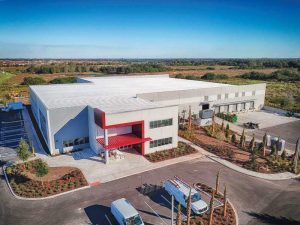
Sometimes, local codes will dictate other instances when and where sprinklers are required. If questions arise, the primary resource should be the local building official or a fire protection engineering consultant.
Early Suppression Fast Response (ESFR) sprinkler systems continue to be used in major industrial and commercial high-risk properties. The benefits of using these systems include the reduction or elimination of in-rack sprinklers in storage occupancies. ESFR sprinklers deliver a larger volume of water per sprinkler, and often, just one sprinkler is capable of controlling fires or extinguishing them completely.
Metal building systems are suitable when ESFR systems are required. However, for certain tall storage and selected commodities, some buildings exceed the National Fire Protection Association (NFPA) 13 limitations on ESFR sprinklers. Past MBMA tests conducted at Factory Mutual (FM Global) showed that up to 13.7-m (45-ft) building ceiling heights are acceptable for EFSR systems under certain conditions. This criterion is now reflected in chapter 16 of the NFPA 13.
Use of SFRM in metal buildings
Since metal buildings are composed of non-combustible steel framing, they do not require additional fire protection. When a fire-resistance rated assembly is required, assemblies with gypsum board are more common, whereas the use of SFRM in metal buildings is not. However, it could be an advantage to use SFRM in an active warehouse environment, where gypsum board could be continually damaged and, as a result, may need regular repairs or replacement.
One reason why SFRM is not the common choice in metal buildings is because there are no SFRM assemblies for thin cold-formed steel sections commonly used as secondary members in these structures. Another reason is, in addition to fire protection, gypsum board can provide an acceptable interior finish, while SFRM does not. Intumescent coatings are not commonly used in metal buildings, though they could be used in similar situations as SFRM. Intumescent paint does provide a much cleaner and more attractive look than SFRM, with an open visual expression of the steel framing; however, such coatings are a higher cost material.




